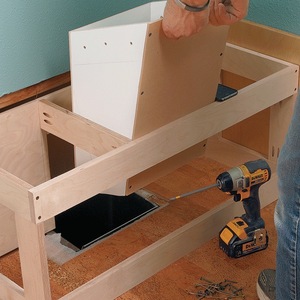Hello all,
I have acouple electrical boxes that are shy of the surface of the wall board which probably will not be too much of a problem, but what about if I were to add wall tile? Any advice? The wall tile is about 1/4″.
Thanks for the help, Turtleboy


















Replies
First talk to your inspector, the tile and wall board are fire resistent so he/she may let it go otherwise your electrical supply house (not HD) will have extensions.
Bing
Thanks Bing for the info. I'll check with the electreical guy up the road for the extentions.
Turtleboy
My local HDs now carry the extensions, in single-wide and double-wide.
Here's a trick. When mounting your receptacle and there is no support for the plug (drywall cutout too big, box is too deep) get a couple of 6/32 screws and nuts that are long enough to get a grip on the box. Put the screw into the receptacle (plug or switch) and screw the nut snug to the back. Now screw the receptacle into the box until it is flush with wall.
If this is not clear, let me know and I will send a picture.
You get out of life what you put into it......minus taxes.
Marv
Thanks for the info but a picture will help.
Thanks again Turtleboy
hope this is legible.You get out of life what you put into it......minus taxes.
Marv
I like Marv's idea, but in the past I've used some small plastic tubing and snipped enough to use as a spacer over the screw. As the tubing squishes down, the outlet is held tight.
Marv, that's a sweet little trick that fits under the "why didn't I think of that?" category. I never would have, of course, but I will definitely file it for future reference, if you don't mind. Thanks.
And thanks to Turtleboy for asking the question.
Thanks to you and Marv for the info. Having extentions seems like a good idea when you know you'll put tile on a wall but are not sure how thick the stuff will be.
Thanks again for the help.
Turtleboy
Definitely use a box extender to bring the face fo the box out so it's flush with the finished wall material.
Supply houses, and even HD, sell rigid plastic extenders that bring the face of the bow out 1/4", 1/2", and 3/4". I've seen 1" ones as well.
You can also get an adjustable metal extender that slips inside the box and can slide in or out, out to maybe 1 1/4" or so. When using metal extenders I wrap the outlet or switch with electrical tape to keep the screws from hitting the metal extension ring.
There's an slicker device if you're doing the rough wiring on a wall whose finished thickness is not known. You can buy adjustable electrical boxes. You nail or screw the mounting plate to the studs as usual, but inside the box there's a jackscrew that moves the box in and out. You let the wall finish go on as it likes, and then screw the box out until it is flush with the finished surface. Even HD stocks these things.
The box extensions that they are talking about are callecd Plaster Rings.
Dave
Thanks to all for the info and help.
Turtleboy
Dave
Not necessarily, if the drywall already on its tough to change a plaster ring however elec supply houses do carry extension rings that are the size of the openning. works similar to the earlier thread about screws and nut to hold recep at wall openning but also give you fire protection
Bing
No, plaster rings are something else. You screw a plaster ring on the front of a box and then plaster or drywall over it. After the wall finish is applied, you can't change the plaster ring. Box extensions are things that you insert through the opening in the finished wall.
On occasion I've cut the required depth off the front of an extra box and used that for a spacer.
I'm not an electrician, but I believe that the NEC requires a "fire ring" whenever the device (outlet) is installed out from the box.
It is just kind of an extension that, in effect makes the box deeper. Not sure if that what was refered to above as and "extension". Fire rings used to be made of metal but now they have plastic ones too. Back when they used the metal ones, I used to joke with the electrician "do they call that a fire ring because it prevents or causes fires?" ; It just seemed to me that the metal ones would cause shorts...
For a pic, take a look at this link - they look pretty close to this:
http://www.carlon.com/GraphicsGallery/Zip%20Box%20Blue%20Outlet%20and%20Switch%20Boxes/High%20Res/B1EXTB-Hi%20Res.jpg
They sell plastic spacers, a.k.a. "caterpillars" for this purpose. They even have them at HD. OK to use if the wall material is non-combustible and the local authorities say OK.